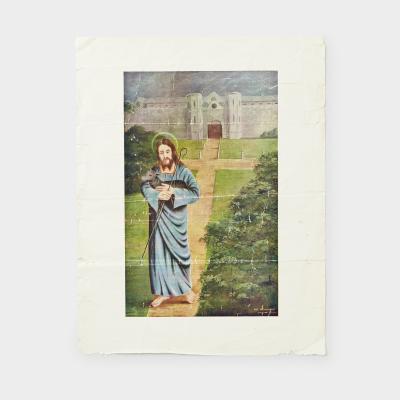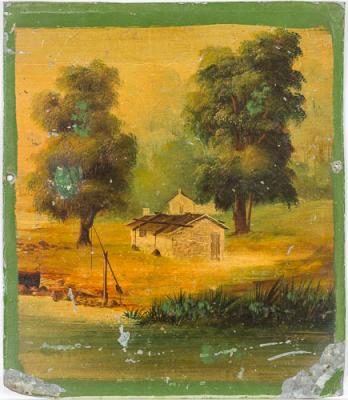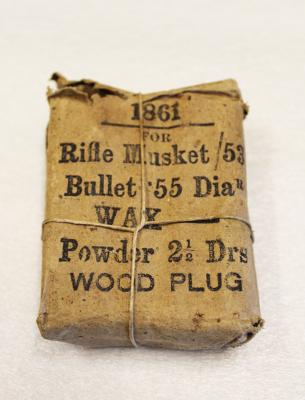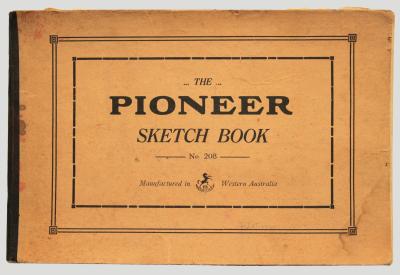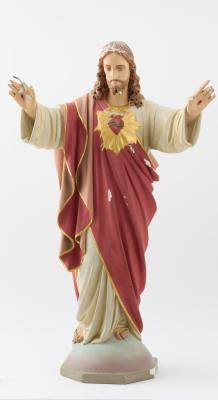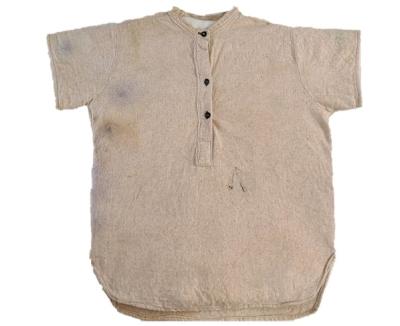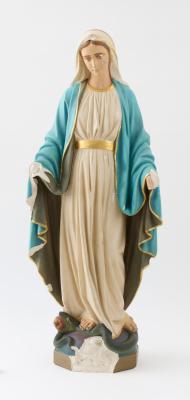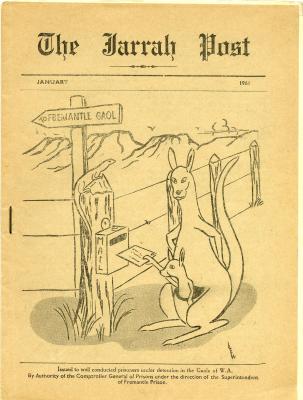MODEL OF SAILING SHIP BY SHINER RYAN
1930 - 1939Large, white, mixed material, model sailing ship. Model of sailing ship, constructed from mixed white material, hand made by Shiner Ryan. Three masted vessel with seven sets of sails fully rigged. Pennant atop central mast has vessel name printed on it, '[...]DOLIA'. Whole model coated in finely ground glass. Set on rectangular wooden base with blue crushed glass inlay.
Made in Fremantle Prison. Shiner Ryan made his boats out of a range of materials including one made of porridge. This has lead to his boats being apocryphally referred to as porridge boats, however it is not believed this boat contains any porridge.
Details
Details
Ernest 'Shiner' Ryan was an artist who served time in Fremantle Prison during 1905, from 1932 to 1936 and again in 1938. Born in 1886, his criminal career began at an early age, when he was first charged with larceny at the age of 16. He is noted as being the first criminal to use a motor vehicle in a getaway, after he and Samuel Freeman robbed the Everleigh Railway Workshop in Sydney in 1914. Convicted of this crime, he spent ten years in a New South Wales gaol.
After his release, Shiner Ryan was sentenced to a further eight years imprisonment in Adelaide for breaking into a bank. His term was later increased after a skilful escape when Ryan managed to make clay moulds of the various locks in the Prison, from which he made his own set of keys and walked out the gates. When he was recaptured, Ryan presented the keys he had made to the Governor, who was so impressed with their workmanship that he added them to the official collection for the Prison’s regular use.
Once released from Adelaide, Ryan moved to Western Australia, where he was caught shop-breaking and first sentenced to time at Fremantle Prison. Whilst serving a later sentence at Fremantle in 1934, Ryan drafted the original drawing of his painting, The Reclamation. The painting, “symbolises the Saviour showing his love for mankind by reclaiming a black sheep of society - a prisoner who has just been released from gaol”. Following his release from Fremantle Prison, Ryan donated this painting, of which 400 copies were made and sold to raise funds for the Fremantle Citizens' Reception Council, an organisation that provided entertainment for serving troops.
Ryan also made model boats from glass, sand and other available materials, including porridge. His model ship, the Kathleen Anne was named after a friend. While serving time at Fremantle Prison, Ryan also looked after the Gatehouse clock. He is noted as being the only person in 50 years to make the clock keep time. It was also discovered that he had been making fake coins in the Prison’s workshop, when a senior Prison Officer was found spending them in Fremantle’s hotel bars.
After his release from Fremantle Prison, Ryan worked as a painter, well sinker, locksmith and watchmaker in the local area. Ryan then married Kate Leigh in 1950, though they separated six months later. By 1953 Ryan was in poor health from asthma, and could no longer work or pay rent. It is reported that one day he presented his landlord with a huge bunch of keys, jokingly saying, “Take these instead of rent, they’ll open any door in Fremantle”.
Shiner Ryan died in 1957, aged 71. The Mayor of Fremantle at the time, Frederick Samson, was a pallbearer at this funeral. When Kate Leigh heard the news, she proclaimed, “His brain was in his finger, he could open any lock with a coat hanger.”
The model boats in the Shiner Ryan collection where made by the artist during his incarceration at Fremantle Prison. The landscape painting on tin (1998.2) was donated by a visitor to the Prison, whose extended family member had received the painting as a personal gift from Ryan. The handwritten poem (2016.56), signed by Ryan and dated 1942, was donated to the Prison’s Collection by a visitor, who had acquired it from his grandfather and who was acquainted with Ryan.
